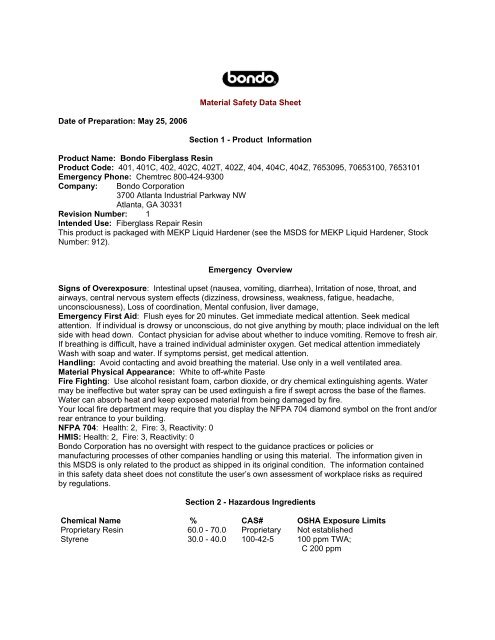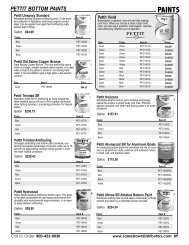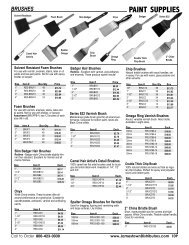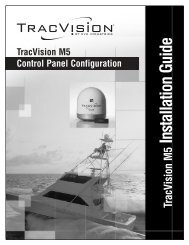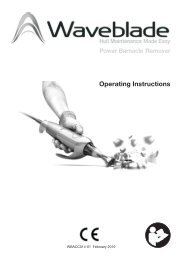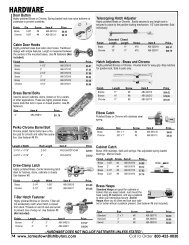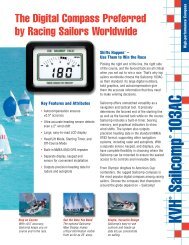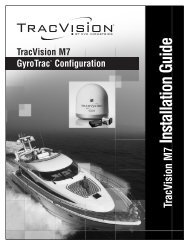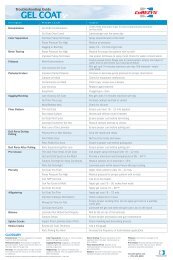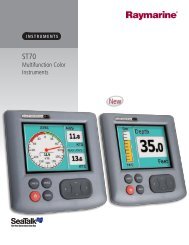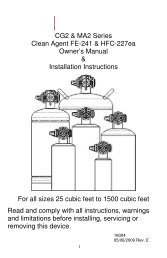Bondo Fiberglass Resin
Bondo Fiberglass Resin
Bondo Fiberglass Resin
You also want an ePaper? Increase the reach of your titles
YUMPU automatically turns print PDFs into web optimized ePapers that Google loves.
Material Safety Data Sheet<br />
Date of Preparation: May 25, 2006<br />
Section 1 - Product Information<br />
Product Name: <strong>Bondo</strong> <strong>Fiberglass</strong> <strong>Resin</strong><br />
Product Code: 401, 401C, 402, 402C, 402T, 402Z, 404, 404C, 404Z, 7653095, 70653100, 7653101<br />
Emergency Phone: Chemtrec 800-424-9300<br />
Company:<br />
<strong>Bondo</strong> Corporation<br />
3700 Atlanta Industrial Parkway NW<br />
Atlanta, GA 30331<br />
Revision Number: 1<br />
Intended Use: <strong>Fiberglass</strong> Repair <strong>Resin</strong><br />
This product is packaged with MEKP Liquid Hardener (see the MSDS for MEKP Liquid Hardener, Stock<br />
Number: 912).<br />
Emergency Overview<br />
Signs of Overexposure: Intestinal upset (nausea, vomiting, diarrhea), Irritation of nose, throat, and<br />
airways, central nervous system effects (dizziness, drowsiness, weakness, fatigue, headache,<br />
unconsciousness), Loss of coordination, Mental confusion, liver damage,<br />
Emergency First Aid: Flush eyes for 20 minutes. Get immediate medical attention. Seek medical<br />
attention. If individual is drowsy or unconscious, do not give anything by mouth; place individual on the left<br />
side with head down. Contact physician for advise about whether to induce vomiting. Remove to fresh air.<br />
If breathing is difficult, have a trained individual administer oxygen. Get medical attention immediately<br />
Wash with soap and water. If symptoms persist, get medical attention.<br />
Handling: Avoid contacting and avoid breathing the material. Use only in a well ventilated area.<br />
Material Physical Appearance: White to off-white Paste<br />
Fire Fighting: Use alcohol resistant foam, carbon dioxide, or dry chemical extinguishing agents. Water<br />
may be ineffective but water spray can be used extinguish a fire if swept across the base of the flames.<br />
Water can absorb heat and keep exposed material from being damaged by fire.<br />
Your local fire department may require that you display the NFPA 704 diamond symbol on the front and/or<br />
rear entrance to your building.<br />
NFPA 704: Health: 2, Fire: 3, Reactivity: 0<br />
HMIS: Health: 2, Fire: 3, Reactivity: 0<br />
<strong>Bondo</strong> Corporation has no oversight with respect to the guidance practices or policies or<br />
manufacturing processes of other companies handling or using this material. The information given in<br />
this MSDS is only related to the product as shipped in its original condition. The information contained<br />
in this safety data sheet does not constitute the user’s own assessment of workplace risks as required<br />
by regulations.<br />
Section 2 - Hazardous Ingredients<br />
Chemical Name % CAS# OSHA Exposure Limits<br />
Proprietary <strong>Resin</strong> 60.0 - 70.0 Proprietary Not established<br />
Styrene 30.0 - 40.0 100-42-5 100 ppm TWA;<br />
C 200 ppm
Section 3 – Hazards Identification<br />
Routes of Entry: Eye contact, Skin contact, Inhalation, Ingestion,<br />
Target Organs Potentially Affected by Exposure: Skin, Liver, Eyes, Respiratory Tract, Nervous System,<br />
Chemical Interactions That Change Toxicity: None Known,<br />
Medical Conditions Aggravated by Exposure: Skin disease including eczema and sensitization, Liver<br />
disease, Eye disease, Respiratory disease including asthma and bronchitis,<br />
Immediate (Acute) Health Effects by Route of Exposure<br />
Inhalation Irritation: Can cause moderate respiratory irritation, dizziness, weakness, fatigue, nausea and<br />
headache.<br />
Inhalation Toxicity: Vapor harmful. May affect the brain or nervous system causing dizziness, headache<br />
or nausea. Causes nose and throat irritation. Non-Toxic. Not known to cause systemic damage.<br />
Skin Contact: Can cause moderate skin irritation, defatting, and dermatitis. Not likely to cause permanent<br />
damage.<br />
Skin Absorption: No absorption hazard in normal industrial use. Component(s) may be absorbed through<br />
intact skin, but it is unlikely that harmful affects will occur unless contact is prolonged, repeated, and<br />
extensive.<br />
Eye contact: Can cause moderate irritation, tearing and reddening, but not likely to permanently injure<br />
eye tissue.<br />
Ingestion Irritation: Irritating to mouth, throat, and stomach. Can cause abdominal discomfort, nausea,<br />
vomiting and diarrhea. Small amounts (a tablespoonful) swallowed during normal handling operations are<br />
not likely to cause injury; swallowing amounts larger than that may cause injury.<br />
Ingestion Toxicity: slightly toxic<br />
Long-Term (Chronic) Health Effects<br />
Carcinogenicity: Contains a substance that is a possible cancer hazard based on high dose animal<br />
studies and/or a human study.<br />
Reproductive and Developmental Toxicity: Contains a substance(s) that is a possible reproductive<br />
system hazard based on high dose tests with laboratory animals.<br />
Mutagenicity: No data available to indicate product or any components present at greater than 0.1% is<br />
mutagenic or genotoxic.<br />
Inhalation: Upon prolonged and/or repeated exposure, can cause moderate respiratory irritation,<br />
dizziness, weakness, fatigue, nausea and headache.<br />
Skin Contact: Upon prolonged or repeated contact, can cause moderate skin irritation, defatting, and<br />
dermatitis. Not likely to cause permanent damage.<br />
Skin Absorption: Upon prolonged or repeated exposure, no hazard in normal industrial use.<br />
Ingestion: slightly toxic<br />
Section 4 – First Aid Measures<br />
Inhalation: Remove to fresh air. If breathing is difficult, have a trained individual administer oxygen. If not<br />
breathing, give artificial respiration and have a trained individual administer oxygen. Get medical attention<br />
immediately If you experience difficulty in breathing, leave the area to obtain fresh air. If continued difficulty<br />
is experienced, get medical attention immediately.<br />
Eyes: Flush eyes with plenty of water for at least 20 minutes retracting eyelids often. Tilt the head to<br />
prevent chemical from transferring to the uncontaminated eye. Get immediate medical attention. In case of<br />
eye contact, flush immediately with plenty of water for at least 15 minutes and get medical attention<br />
immediately; for skin, wash thoroughly with soap and water.<br />
Skin Contact: Wash with soap and water. Remove contaminated clothing and launder. Get medical<br />
attention if irritation develops or persists.<br />
Ingestion: Do not induce vomiting and seek medical attention immediately. Provide medical care provider<br />
with this MSDS. If swallowed, do not induce vomiting. Get medical attention immediately.<br />
Notes to Doctor: No additional first aid information available
Section 5 – Fire Fighting Measures<br />
Flammability Summary: Flammable<br />
Extinguishing Media: Use alcohol resistant foam, carbon dioxide, or dry chemical extinguishing agents.<br />
Water may be ineffective but water spray can be used extinguish a fire if swept across the base of the<br />
flames. Water can absorb heat and keep exposed material from being damaged by fire.<br />
Fire and/or Explosion Hazards: Vapors may be ignited by sparks, flames or other sources of ignition if<br />
material is above the flash point giving rise to a fire (Class B). Vapors are heavier than air and may travel to<br />
a source of ignition and flash back.<br />
Fire Fighting Methods and Protection: Do not enter fire area without proper protection including selfcontained<br />
breathing apparatus and full protective equipment. Fight fire from a safe distance and a<br />
protected location due to the potential of hazardous vapors and decomposition products. Flammable<br />
component(s) of this material may be lighter than water and burn while floating on the surface. Use water<br />
spray/fog for cooling. Flammable component(s) of this material may be lighter than water and burn while<br />
floating on the surface.<br />
Hazardous Combustion Products: Carbon dioxide, Carbon monoxide, Hydrocarbons,<br />
Flash Point (SFCC): 27 deg. C 80 deg. F<br />
Lower Flammable/Explosive Limit: Not determined<br />
Section 6 - Accidental Release<br />
Personal Precautions and Equipment: Exposure to the spilled material may be irritating or harmful.<br />
Follow personal protective equipment recommendations found in Section 8 of this MSDS. Additional<br />
precautions may be necessary based on special circumstances created by the spill including; the material<br />
spilled, the quantity of the spill, the area in which the spill occurred. Also consider the expertise of<br />
employees in the area responding to the spill.<br />
Evaporation of volatile substances can lead to the displacement of air creating an environment that can<br />
cause asphyxiation.<br />
Methods for Clean-up: Prevent the spread of any spill to minimize harm to human health and the<br />
environment if safe to do so. Wear complete and proper personal protective equipment following the<br />
recommendation of Section 8 at a minimum. Dike with suitable absorbent material like granulated clay.<br />
Gather and store in a sealed container pending a waste disposal evaluation.<br />
Shut off ignition sources; including electrical equipment and flames. Do not allow smoking in the area.<br />
Section 7 – Handling and Storage<br />
Handling Technical Measures and Precautions: Harmful or irritating material. Avoid contacting and<br />
avoid breathing the material. Use only in a well ventilated area. Use spark-proof tools and explosion-proof<br />
equipment.<br />
Storage Technical Measures and Conditions: Store in a cool dry ventilated location. Isolate from<br />
incompatible materials and conditions. Keep container(s) closed. Keep away from sources of ignition.<br />
Section 8 – Exposure Controls/Personal Protection<br />
Engineering Measures: No exposure limits exist for the constituents of this product. Use local exhaust<br />
ventilation or other engineering controls to minimize exposures and maintain operator comfort.<br />
Respiratory Protection: Respiratory protection may be required to avoid overexposure when handling<br />
this product. General or local exhaust ventilation is the preferred means of protection. Use a respirator if<br />
general room ventilation is not available or sufficient to eliminate symptoms. Wear a NIOSH approved<br />
respirator if levels above the exposure limits are possible.<br />
Eye Protection: Wear chemically resistant safety glasses with side shields when handling this product.
Skin Protection: Wear protective gloves. Inspect gloves for chemical break-through and replace at regular<br />
intervals. Clean protective equipment regularly. Wash hands and other exposed areas with mild soap and<br />
water before eating, drinking, and when leaving work<br />
Gloves: Required for prolonged or repeated contact. Use solvent resistant gloves. Barrier creams are not<br />
substitutes for full physical protection. Refer to safety equipment supplier for effective glove<br />
recommendations.<br />
Control Parameters:<br />
Chemical Name ACGIH TLV-TWA ACGIH STEL IDLH<br />
Proprietary <strong>Resin</strong> Not established Not established Not determined<br />
Styrene<br />
20 ppm TWA;<br />
85 mg/m3 TWA<br />
40 ppm STEL;<br />
170 mg/m3 STEL<br />
Not determined<br />
Section 9 – Physical and Chemical Properties<br />
Physical State: Paste<br />
Color: White to off-white<br />
Odor: Strong Solvent<br />
pH: Not determined<br />
Solubility in Water: Not determined<br />
Volatiles, % by weight: 33.8<br />
Volatiles, % by volume: 42.61<br />
Volatile Organic Compounds excluding exempt solvents and water:<br />
3.21 Lb/gallon 385.03 g/l<br />
Volatile Organic Compounds including exempt solvents and water:<br />
3.21 LB/gallon 385.03 g/l<br />
Vapor Density: 3.6000000<br />
Vapor Pressure: Not determined<br />
Boiling Point: 145.0000000 deg. C; 293 deg. F<br />
Specific Gravity: 0.905<br />
Weight per Gallon: 9.5144<br />
Section 10 – Stability and Reactivity<br />
Stability: Stable under normal conditions. May become unstable at elevated temperatures and/or<br />
pressure.<br />
Conditions to Avoid: Sparks, open flame, other ignition sources, and elevated temperatures.<br />
Materials to Avoid/Chemical Incompatibility: Strong oxidizing agents, Peroxides, Strong acids,<br />
Hazardous Decomposition Products: Hydrocarbons, Carbon monoxide, Carbon dioxide,<br />
Section 11 - Toxicological Information<br />
Sensitization (effects of repeated exposure): No data<br />
Component Toxicology Data (NIOSH)<br />
Chemical Name CAS Number LD50/LC50<br />
Proprietary <strong>Resin</strong> Proprietary No Data Available<br />
Styrene 100-42-5 Inhalation LC50 Rat: 12 gm/m3/4H;<br />
Inhalation LC50 Mouse: 9500 mg/m3/4H;<br />
Oral LD50 Rat: 2,650 mg/kg
Section 12 - Ecological Information<br />
Overview:<br />
Avoid runoff into ground, storm drains or sewers that lead into waterways. Water runoff may cause<br />
environmental damage. There are extensive ecological data available on the various components of these<br />
products. An adequate representation of all these data is beyond the scope of this document. Please<br />
contact the information phone number found in Section 16.<br />
Section 13 – Disposal Information<br />
Waste Description for Spent Product: Spent or discarded material is a hazardous waste.<br />
Disposal Methods: Dispose of in accordance with federal, state or provincial and local pollution<br />
requirements. Clean preferably with a detergent, avoid the use of solvents. This information applies only<br />
to the material as manufactured; processing, use or contamination may make this information<br />
inappropriate, inaccurate or incomplete. The generator of the waste has the responsibility for proper waste<br />
classification, transportation and disposal.<br />
Waste Disposal Codes: D001<br />
Section 14 – Transportation Information<br />
DOT Shipping Information:<br />
DOT: Consumer Commodity, ORM-D<br />
IMDG: UN 3269, Polyester <strong>Resin</strong> Kit, 3, III, LTD QTY, Flash Point 27C,<br />
EmS F-E, S-D<br />
Section 15 - Regulatory Information<br />
Note: Materials listed in this section may be present as trace level contaminants to raw materials. Check<br />
Section 2 - Hazardous Ingredients to determine if a significant amount is present<br />
OSHA: This product is considered hazardous under the Federal OSHA Hazard Communication Standard.<br />
WHMIS: B2, D2A, D2B,<br />
SARA Title III:<br />
Section 302 Extremely Hazardous Substances: None<br />
Section 311 / 312 Hazard Categories: Immediate health, delayed health, fire hazard.<br />
Section 313 Toxic Chemicals: Styrene,<br />
You may be required to submit this MSDS to state and local emergency response agencies (SERC &<br />
LEPC) and to your local fire department. Also, you may be affected by other sections of this law,<br />
depending on the chemicals and amounts that you inventory at your location. To learn more about your<br />
responsibilities, call the EPA Hotline (800) 535-0202<br />
TSCA status: All components in this product are on the TSCA Inventory.<br />
Canadian Domestic Substances List: The components of this product ARE listed on the Canadian<br />
Domestic Substances List.<br />
Proposition 65: WARNING: This product contains a chemical known to the state of California to cause<br />
cancer and birth defects, or other reproductive harm.<br />
Section 16 - Preparation Information<br />
Prepared by <strong>Bondo</strong> Corporation<br />
Information phone number: (404) 696-2730<br />
Do not handle until the manufacturer’s safety precautions have been read and understood. Regulations<br />
require that all employees be trained on Material Safety Data Sheets for all products with which they come<br />
in contact.<br />
While <strong>Bondo</strong> Corporation believes that the data contained herein are accurate and derived from qualified<br />
sources, the data are not to be taken as a warranty or representation for which <strong>Bondo</strong> Corporation<br />
assumes legal responsibility. They are offered solely for your consideration, investigation and verification.
Any use of these data and information must be determined by the user to be in accordance with applicable<br />
federal, state or provincial and local laws and regulations.


